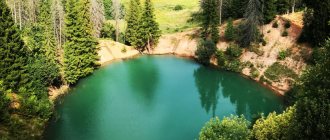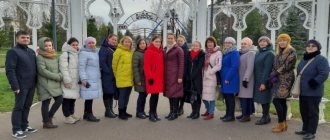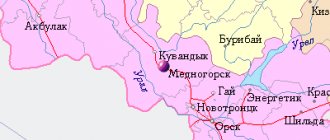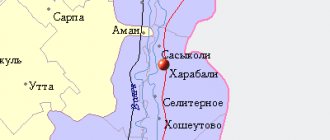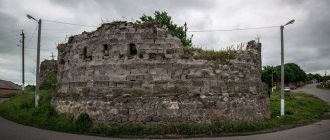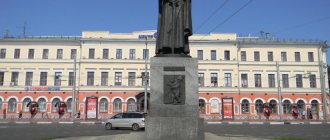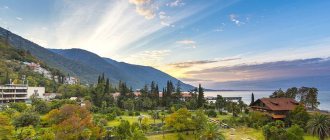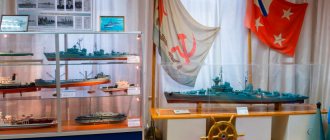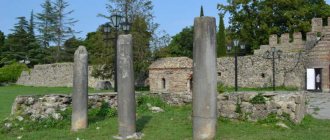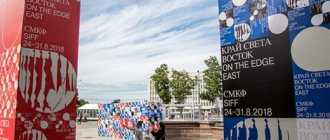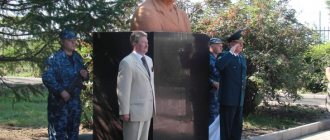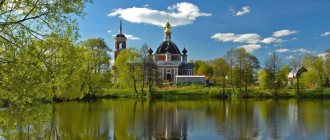City of Zvenigovo (Mari El)
Workers' cooperative of water workers in Zvenigovo. Photo from the 1920s.
Zvenigovo (otherwise known as the backwater of Chekursky, Zvenigovsky, Zvenizhsky or Provoy) is a city (since 1974) in the Republic of Mari El, the center of the Zvenigovsky district. Located on the left bank of the Volga in the area of the Kuibyshev reservoir, 90 km south of Yoshkar-Ola and 32 km from the nearest railway station Shelanger. The population of Zvenigovo in 2022 is 12,484 people; in terms of population, the city was in 886th place out of 1,115 cities in the Russian Federation.
Several place names have their own explanation. Opposite the backwater, where the construction of the future plant began in 1860, the Russian settlement of Chekur initially arose. This is where one of the names of the backwater came from - Chekursky.
Another name - Zvenizhsky (Zvenigovsky) comes from the name of the small river Zveniga flowing into the backwater. At one time, some residents called this village Provoy, this word is a local version of the Russian definition of “steam” and was associated with the presence of a ship repair yard. The origin of the name of the future city was also sometimes explained by the loud ringing sound made at the factory.
The emergence of an industrial center in this place is associated with the development of river transportation. In the middle of the 19th century. There were no settlements on the left bank of the Volga. There were islands and a two-kilometer backwater - the Zvenigovsky (Zvenizhsky) backwater, into which the Zveniga River flowed. On the right bank there were settlements of Chekury, where fishermen and barge haulers lived, and in winter there was a camp in Chekury for convoys traveling along the Volga.
After completing navigation, Volga steamships and barges were sent to “winter lay-up” and for repairs in bays and at the mouths of small rivers. In the winter of 1859-1860. The backwater at the confluence of the Zveniga and the Volga became a wintering place for the ships of the joint-stock shipping company "Druzhina".
This enterprise was founded in 1858 by the owners of a mechanical plant in Kostroma, brothers A.P. and SP. Shilovs. By 1860, the company already had 16 steamships, including 7 passenger and 9 tugboats, which plied between Rybinsk and Nizhny Novgorod. To expand the repair base and accommodate ships in the winter, the “Druzhina” chose a backwater in a wooded area almost uninhabited by people on the left bank of the Volga, 70 versts above the city of Kazan and 52 versts below the city of Cheboksary. Although the backwater is located on the meadow side of the river, the bank there is so high that during high water it remains inaccessible to flood waters. The length of the backwater was 2 km, width - 150-200 meters, depth - about 5 meters.
Vessels wintering in Zvenigovo
The land belonged to the peasants of the Krasnoyarsk and Oshurga communities. After the winter was successfully completed, in 1860 the shipping company rented 15 acres from the land owners for a small fee. Here in 1860 the first mechanical workshops were founded. Subsequently, warehouses, houses for management and workers' barracks were erected nearby. That is why 1860 is considered the year of foundation of Zvenigov.
Initially, a forge, a metalworker, a barn for storing building materials and 4 outbuildings for craftsmen were built on the shore of the backwater. In 1863, a steam engine and 4 mechanical machines operated here, and several barracks for craftsmen were built.
In 1878, a wooden church was erected at the plant in the name of the saint and wonderworker Nicholas, the furnishings and utensils for which were collected by subscription by employees and craftsmen of the enterprise. In the same year, “Druzhina” opened a school for forty children of both sexes. For the treatment of workers and members of their families there was a separate outbuilding and a pharmacy with a permanent paramedic. The Druzhina shipping company also contained three trading establishments - a grocery store, a textile shop and a Rhine cellar.
On the banks of the Volga there were timber warehouses with stacks of wood and lumber. Rafts were tied here, and hundreds of thousands of cubic meters of timber were floated down the Volga every year on barges and rafts. The trade was carried out by timber merchant A.T. Zimin. To prevent residents of the backwater and nearby villages from engaging in unauthorized logging, on the instructions of the Cheboksary district government, in 1895 they organized a state forestry, opened police and zemstvo stations.
By 1892, there was already a large plant in Zvenigovo with three steam engines, two steam boilers, 22 mechanical machines, a steam hammer and other equipment. Four masters worked, under their supervision there were about two hundred workers, artisans and students.
The historical building of the chief mechanic's department of the shipyard in Zvenigovo. Modern photo
The fate of one of the artisans, A.I., is interesting. Gubyrina. He began his career as an apprentice, quickly rose to the rank of mechanic, and then became a plant manager. In 1886-1887 According to his project, three flat-bottomed barges with steam engines and machinery with a capacity of up to 60 thousand pounds of cargo each were built in the Zvenigovsky backwater (in total, the Druzhina had 24 steamships in those years, and up to 150 barges). In 1886-1890 In the backwater, eight steamships of a design improved by Gubyrin were launched.
In 1894, factory workers built the bell tower of the church in the name of St. Nicholas the Wonderworker. The backwater developed, and as the importance of horse-drawn transport declined, Chekurs moved here. By the beginning of the twentieth century. The Zvenigovsky backwater became the industrial center of the area, where engineers and skilled workers appeared.
During the First Russian Revolution, rallies, strikes, and clashes with the police took place here. In the summer of 1906, the unrest of the workers of the Zvenigovsky backwater was suppressed by a punitive expedition that arrived from Kazan on the steamship Missouri.
Fire guard near the Volga near Zvenigovo
In 1904, more than three hundred people lived in the backwater. The streets appeared in the village: Solyanaya (now Gagarina), Lesnaya (now Vershinina), Zavodskaya and Stekolnaya. Local residents wove ropes, prepared bast, baked buns, and made confectionery. All these goods were sold on Sundays at the local market. In addition to the mechanical plant, in the Zvenigovsky backwater in 1906-1913. glass factory operated by I.Ya. Grigorieva.
In 1902, the two-year school in the backwater came under the jurisdiction of the zemstvo and began to be called a school, which from 1908 to 1912. was located in two buildings - two classrooms were on the second floor of the church, two more - in Kambolov’s private house (Vecherkina Street). In 1918, the church burned down, and the Rivermen's Club was subsequently built in its place.
By 1907, the affairs of the “Druzhina” had worsened and the owners of the shipping company decided to get rid of the ships and the plant in the Zvenigovsky backwater. The new owner of the plant is merchant I.I. Tet began dismantling and selling off equipment. The collapse of production was completed by a fire that destroyed almost all the buildings (according to the main version, the fire was organized by the new owner in order to obtain insurance). After the fire, the sawmill and the remains of the buildings were bought by the former plant manager A.N. Nikolaev, timber merchant A.T. Zimin and shipowner A.K. Ivanov. The new company restored the plant and began producing small ships for Kazan shipowners.
There were few production workers and the administration regularly attracted seasonal workers to work. Beginning in 1915, the future chief marshal of aviation K.A. worked as a carpenter as part of a brigade from the Vyatka province in the Zvenigovsky backwater. Vershinin.
In 1920, there was a fire at the ship repair plant, in which the sawmill and lathe shop burned down. In the photo of that time - the exercises of the Zvenigovo fire brigade
After the Civil War, the plant became known as “Red Volgar”. After the restoration of the enterprise, the area around them began to quickly become populated. Residents of the settlement of Chekura moved to the backwater, and peasants from neighboring villages on the left bank also settled here. In 1924, the Zvenigovo canton (later a district) of the Mari Autonomous Region was formed, and at the same time the official name of the settlement was determined - the village of Zvenigovo.
In the pre-war period, a school, a library, a rivermen's club, a forestry enterprise, a creamery and its own newspaper appeared in the village. The mechanical plant was transformed into a ship repair plant (SRZ). Since 1940, he was given the name of Hero of the Soviet Union S.N. Butyakov - a local native, a tank driver who died heroically during the Soviet-Finnish War of 1939-1940.
Since 1968, the plant became the Shipbuilding and Ship Repair Plant (SSRZ) named after. S.N. Butyakova. Volgar pusher tugs, barges and fire guards were produced here. A motor transport enterprise, a road repair and construction department also developed, and infrastructure was formed - a hospital, shops, a hotel, etc. In the 1980s. An underwater passage across the Volga of the Urengoy-Pomary-Uzhgorod gas pipeline system was built near Zvenigov.
In 1974, Zvenigovo received the status of a city and the coat of arms is a shield, on the vertical dividing line there is a seagull and an anchor, one half of the coat of arms is red, indicating the revolutionary past, the second blue is the Volga
According to pilot charts, Zvenigovo is located on the left bank of the Volga, opposite the 1240th kilometer of the shipping route. The width of the Volga here is about 2.5 km. Since 1958, after the construction of the Volzhskaya Hydroelectric Power Station named after. IN AND. Lenin and the filling of the Kuibyshev reservoir, this is the so-called zone of wedging out the backwater of the reservoir. The water level was raised by about 8 m, and the current state of the reservoir corresponds to the state of the Volga during the flood. The shipping passage has a depth of more than 15 m (vessels of the “river-sea” type passed freely). The current is fast, about 1 meter per second. The main wealth of the river is fish. Here they catch bream, perch, pike perch, asp and catfish.
Zvenigovo is developing in the space between the Volga, Ilet and Malaya Kokshaga
The height of the right, root side of the valley reaches 100 m. At the foot opposite Zvenigov there are two huge landslides called “Two Brothers”. The attraction of these places is the numerous ravines, similar to mountain gorges. Their depth reaches 50-70 m, they overlook the interfluve and have a length from 400 m to 1 km. There is game (birds, hares) in the local forest, and hunting is underway.
The beaches are conditional - at high water levels there are none at all, and the level depends on the Volzhskaya Hydroelectric Power Station named after. V.I. Lenin - the greater the water consumption, the lower the level, as well as the Cheboksary hydroelectric station located above - the greater the water consumption, the higher the level.
Outside the city, there are ancient sand dunes 5-7 m high, stretching hundreds of meters in length. They are adjacent to small swamps. Around the city there is a forest, mainly coniferous and pine. Three kilometers east of the city there is a sacred Mari grove - kusoto Mikola Kuryk.
Among the city enterprises, the shipbuilding and ship repair plant named after. Butyakova S.N., timber processing plant, Resurs LLC and Zvenigovsky city dairy plant. Despite its small area, the city has a fairly long coastline. There are many cafes and beaches on the shore.
The shipbuilding and ship repair plant (JSC SSRZ named after S.N. Butyakov) is a city-forming enterprise, the population of the city is to one degree or another connected with it. In the photo - sudra in winter repair
In the early 1990s, they began to restore the St. Nicholas Church in Zvenigovo, which during the years of Soviet power was transferred to the house of pioneers. In 1993, builders completed restoration work, and the dome with a cross was restored over the church.
In 1995, a repeater came into operation, allowing city residents to watch programs from the Mari El State Television and Radio Broadcasting Company. At the end of the 1990s, a new telecommunications center with an automatic telephone exchange with 5,000 numbers was put into operation, and gasification of the individual sector was carried out. In 2000, in the building of the former department of education on the street. Kooperativnaya, 23, a local history museum has been opened. Historical monuments of the city are the building of the first hospital of the canton built in 1889, the building of the department of the chief mechanic and "Karavanka" (1892), the first school in the village of Zvenigovo (1902). Archaeological monuments include the Bolshaya Gora-sanctuary, the Zvenigovskoe settlement and two Zvenigovskoye sites.
Population
| Population | ||||||||
| 1931[4] | 1939[4] | 1959[5] | 1970[6] | 1979[7] | 1989[8] | 1992[4] | 1996[4] | 1998[4] |
| 2500 | ↗5200 | ↗7213 | ↗8597 | ↗12 013 | ↗14 239 | ↗14 800 | ↘14 600 | ↘14 400 |
| 2000[4] | 2001[4] | 2002[9] | 2003[4] | 2005[4] | 2006[4] | 2007[4] | 2008[10] | 2009[11] |
| ↘14 200 | ↘14 100 | ↘12 722 | ↘12 700 | ↘12 500 | ↘12 400 | ↘12 300 | →12 300 | ↘12 179 |
| 2010[12] | 2011[4] | 2012[13] | 2013[14] | 2014[15] | 2015[16] | 2016[17] | 2017[18] | 2018[19] |
| ↘11 946 | ↘11 900 | ↘11 848 | ↘11 764 | ↘11 729 | ↘11 681 | ↘11 504 | ↘11 379 | ↘11 204 |
| 2019[20] | 2020[21] | 2021[2] | ||||||
| ↘11 049 | ↘10 904 | ↗10 966 | ||||||
As of January 1, 2022, in terms of population, the city was in 885th place out of 1116[22]cities of the Russian Federation[23].
Notable forests and woodlands
Most of the region is occupied by forests. Pine forests, birch groves, oak groves are a source of special pride for the Mari. It was from the trees that they asked for protection and shared their joy with them, because according to the Faith of the Ancestors, every tree is a Deity. But not all of them are light, there are also evil spirits whose goal is to cause pain to people. These are the ones you need to know about and beware of, and this knowledge must be passed on to your descendants.
Karamas forest
- Coordinates: 56.693637, 49.005685.
For a long time, this forest was considered a mysterious place, and legends and traditions associated with it have been preserved to this day. It was located between two old villages that have not survived to this day.
The places were remote and attracted robbers. Moreover, the Urzhum highway passed through the forest, along which merchant carts traveled.
The robbers killed the merchants and threw the corpses in the forest without burying them. And after some time, the villagers began to hear the voices of the dead at night and at dusk, but no one was visible.
Sendinskaya larch grove
- Coordinates: 56.807210, 49.976041.
This is a very small area on the territory of the Mari-Turek district. It recently received the status of a specially protected natural monument and for good reason. After all, the Sukachev larches that grow here are over 100 years old.
The first plantings of this valuable crop were made at the beginning of the 20th century, before the First World War. Any agricultural activity that could damage trees is prohibited here. And you can admire the beautiful larches as much as you like.
Notes
- Zvenigov city administration (Russian). Date accessed: February 14, 2022. Archived January 12, 2022.
- ↑ 12
The permanent population of the Russian Federation by municipalities as of January 1, 2022 (Russian). Retrieved April 27, 2022. Archived May 2, 2022. - ↑ 1 2
Zvenigovo (backwater Chekursky, Zvenizhsky, Provoy) |
Native Vyatka (undefined)
. rodnaya-vyatka.ru. Retrieved July 21, 2022. Archived July 21, 2022. - ↑ 123456789101112
People's encyclopedia "My City". Zvenigovo - All-Union Population Census of 1959. The size of the urban population of the RSFSR, its territorial units, urban settlements and urban areas by gender (Russian). Demoscope Weekly. Access date: September 25, 2013. Archived April 28, 2013.
- All-Union Population Census of 1970 The size of the urban population of the RSFSR, its territorial units, urban settlements and urban areas by gender. (Russian). Demoscope Weekly. Access date: September 25, 2013. Archived April 28, 2013.
- All-Union Population Census of 1979 The size of the urban population of the RSFSR, its territorial units, urban settlements and urban areas by gender. (Russian). Demoscope Weekly. Access date: September 25, 2013. Archived April 28, 2013.
- All-Union population census of 1989. Urban population (undefined)
. Archived from the original on August 22, 2011. - All-Russian population census 2002. Volume. 1, table 4. Population of Russia, federal districts, constituent entities of the Russian Federation, districts, urban settlements, rural settlements - regional centers and rural settlements with a population of 3 thousand or more (Russian). Archived from the original on February 3, 2012.
- Cities of the Republic of Mari El (number of inhabitants - estimate as of January 1, 2008, thousand people) (Russian). Retrieved May 21, 2016. Archived May 21, 2016.
- The size of the permanent population of the Russian Federation by cities, urban-type settlements and regions as of January 1, 2009 (Russian). Retrieved January 2, 2014. Archived January 2, 2014.
- All-Russian population census 2010. Population of cities, regions, urban and rural settlements
- Population of the Russian Federation by municipalities. Table 35. Estimation of the resident population as of January 1, 2012 (Russian). Retrieved May 31, 2014. Archived May 31, 2014.
- Population of the Russian Federation by municipalities as of January 1, 2013. - M.: Federal State Statistics Service Rosstat, 2013. - 528 p. (Table 33. Population of urban districts, municipal districts, urban and rural settlements, urban settlements, rural settlements) (Russian). Retrieved November 16, 2013. Archived November 16, 2013.
- Estimation of the resident population in municipalities of the Republic of Mari El as of January 1, 2014 (Russian). Retrieved April 1, 2014. Archived April 1, 2014.
- Population of the Russian Federation by municipalities as of January 1, 2015 (Russian). Access date: August 6, 2015. Archived August 6, 2015.
- Population of the Russian Federation by municipalities as of January 1, 2016 (Russian) (October 5, 2018). Retrieved May 15, 2022. Archived May 8, 2022.
- Population of the Russian Federation by municipalities as of January 1, 2022 (Russian) (July 31, 2017). Retrieved July 31, 2022. Archived July 31, 2022.
- Population of the Russian Federation by municipalities as of January 1, 2022 (Russian). Retrieved July 25, 2018. Archived July 26, 2022.
- Population of the Russian Federation by municipalities as of January 1, 2022 (Russian). Retrieved July 31, 2019. Archived May 2, 2022.
- Population of the Russian Federation by municipalities as of January 1, 2022 (Russian). Date accessed: October 17, 2022. Archived October 17, 2022.
- taking into account the cities of Crimea
- https://rosstat.gov.ru/storage/mediabank/bul_Chislen_nasel_MO-01-01-2021.rar Population of the Russian Federation by municipalities as of January 1, 2022 (1.85 Mb, 07/30/2021)
- Shipbuilding and ship repair plant named after. Butyakova S. N. (undefined)
. Retrieved March 31, 2012. Archived March 12, 2012. - Zvenigovsky city dairy plant. (unspecified)
(inaccessible link). Access date: September 30, 2012. Archived December 11, 2012.
Open air museums
Such ethnographic complexes already exist in all regions of Russia. The Mari Republic is no exception. Here you can learn more about the history and culture of this mysterious people, get acquainted with their epic and taste national dishes.
Ethnographic Museum in Kozmodemyansk
- Address: Promyshlennaya st., 2, Kozmodemyansk.
This museum was created with the aim of preserving antiquities and traditions of the mountain Mari. It opened in 1983. It is noteworthy that many ancient buildings were transported here from Cheboksary in disassembled form. Thanks to this, they were preserved, while their other contemporaries went under water when the Cheboksary hydroelectric station was launched.
The museum's exposition includes 60 buildings for various purposes and more than 7,000 exhibits. Many houses were built without a single nail. In addition, performances are staged in the museum. Visitors are invited to get acquainted with wedding and funeral rites, listen to the playing of the harp and study all aspects of peasant life.
On topic - Sights of Kozmodemyansk
